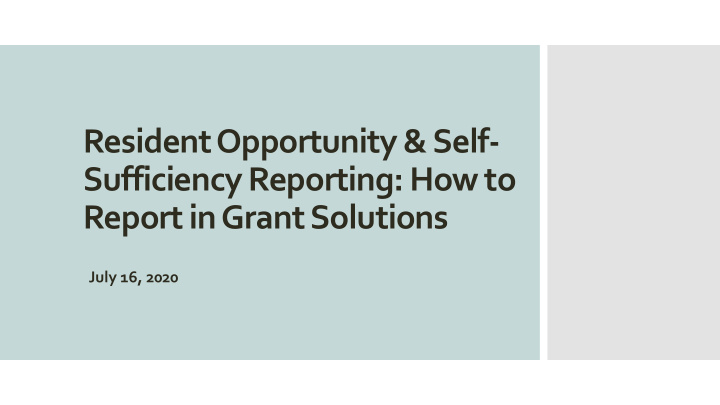



Resident Opportunity & Self- Sufficiency Reporting: How to Report in Grant Solutions July 16, 2020
Trey Youmans, ROSS Program Manager Dina Lehmann-Kim, ROSS Program Manager Thaddeus Wincek, Program Manager Charles Eldridge, National Grant Manager Introductions J’nelle Bigesby, National Grant Manager Joseph Taylor, ONAP National Grant Manager Anna-Lisa Walters, Grant Solutions Libby Youngdale, Grant Solutions Kristin Kuipers, Pangea Foundation
The ROSS Data Guide 3.0 is posted: https://files.hudexchange.info/resources/documents/R OSS-Data-Guide.pdf The ROSS Reporting: ROSS Data Guide 3.0 webinar, Thursday, June 13 is posted: https://www.hudexchange.info/trainings/courses/ross- Reporting reporting-ross-data-guide-3-0/ Resources You can find other training material and resources here: ROSS Webpage: https://www.hudexchange.info/programs/ross/ Standard for Success Webpage: https://www.hudexchange.info/programs/standard s-for-success/
The reporting period is the span of time your annual report will cover. It is the period where grant activities are gathered and reported to HUD. Each reporting period is no more than 12 months. The default dates for the reporting period is October 1 through September 30 which coincides with HUD’s Fiscal Year (FY). The default dates in the InForm Tool will not change. Reporting If your grant term start date is after October 1, then you should Period Dates begin reporting according to the grant term start date in your grant agreement. For example, if your grant term start date is April 1, then your reporting period is April 1 through September 30. Grantees whose final report may end before September 30, will only report up to the grant term end date. For example, if your grant term end date is March 31, then your reporting period for your final report is October 1 – March 31.
Reports are due October 30 of each year except for the final report . The ROSS grant agreement specifies the due date for each report. Report For example, FY16 Grantees’ final reports are due June 30, 2020 unless they have extended their grant term. Submission Grantees must ensure their data is submitted by the report due Due Date date. Grantees may submit a report after October 30, but it will be considered a late submission.
Grantee Report Report Due Reporting Date Period FY16 Final Report June 30, 2020 October 1, 2019 (ROSS17…) (FY20 Report) to January 31, 2020 (see next slide) Reporting Fy17 Year 3 Report October 30, 2020 October 1, 2019 (ROSS18…) (FY20 Report) to September 30, Period and 2020 Due Date FY18 Year 2 Report October 30, 2020 October 1, 2019 (ROSS19…) to September 30, 2020 FY19 Year 1 Report October 30, 2020 June 1, 2020 to (ROSS20…) September 30, 2020
If your grant term was extended and the extended grant term end date is before September 30, 2020, then your reporting period is from October 1, 2019 to your grant term end date. Your final report due date is 90-days from the grant term end date. Fy16 Grantee If your extended grant term end date is after Final Report September 30, 2020 then your reporting period is from October 1, 2019 to September 30, 2020. Your report due is October 30, 2020. This will not be considered your final report.
If you are planning to use the InForm Tool or your own case management software, you will need access to Grant Solutions, Online Data Collection module. Grant Please complete the form sent from ROSS-PIH@hud.gov on July 1, 2020. Solutions Send completed form to help@grantsolutions.gov and Access cc ROSS-PIH@hud.gov. The subject header should be: “Request OLDC Access: [Your Grant Number]”
HUD requires all applicants to develop performance and outcome milestones that will support residents’ path towards economic independence and stability or in the case of elderly/disabled residents assisting them to continue to age/remain in place. Measuring ROSS grantees must develop an effective, Results quantifiable, outcome-oriented plan for measuring performance and determining that goals have been met.
Each area of need has a set of goals and Key Key Performance Indicators (KPIs) HUD expects each grantee to achieve by the end of its grant term. HUD Performance may use data submitted with annual reports to Indicators determine progress towards achievement of these Key Performance Indicators.
The ROSS Data Guide 3.0 lists data elements that are applicable to the ROSS program. Any other data elements [ which you might see in the InForm Tool or other reporting tool ] that are not in the ROSS Data Guide 3.0 will not require a response. Descriptions and comments for each data element can also be found in this Data Quality document. All grantees should ensure that they are responding to the required data and elements Availability Data quality and availability is considered an aspect of a grantee’s performance. Grantees must ensure that your data is accurately reported and submitted to HUD. Your data will allow HUD to observe your program activity and provide recommendations to help improve outcomes for your residents. Therefore, grantees should report on the different types services a resident is receiving. This data should also shape what activities you are providing to residents.
The framework’s three main tenets are: 1. Standardization of data elements 2. Alignment of reported data elements to higher-level agency goals Standard for 3. Utilization of record-level (individual service recipient-level) reports ) reports Success Framework
There are currently four options in which participants can record and submit their Standards for Success data to HUD. 1. GrantSolutions inForm 2. American Association of Service Coordinators Reporting (AASC) Online Tools 3. FamilyMetrics Software 4. Other case management Software
OLDC Demonstration www.grantsolutions.gov
If you have issues with your login: help@grantsolutions.gov Contact If you have technical issues with reporting: AskGMO@hud.gov All other questions: ROSS-PIH@hud.gov Information
Questions ROSS-PIH@hud.gov
Recommend
More recommend